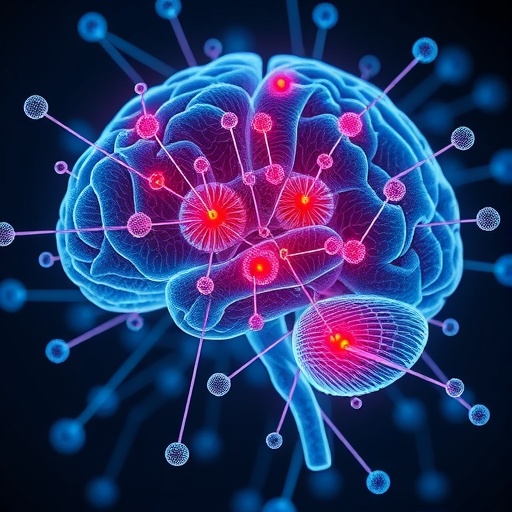Traumatic brain injury (TBI) stands as one of the most formidable challenges in modern medicine, affecting millions worldwide and often resulting in devastating, long-term disabilities. The brain’s intricate architecture and the delicate nature of neural tissues pose substantial hurdles to both diagnosing and treating these injuries effectively. However, a groundbreaking new frontier is emerging in the intersection of nanotechnology and neuroscience, promising to revolutionize TBI management. Spearheaded by Professor Yun Hak Kim at Pusan National University in South Korea, recent research has illuminated transformative advances in theranostic nanomaterials—ingeniously engineered nanoparticles capable of simultaneously diagnosing and treating traumatic brain injuries.
At its core, the challenge in TBI treatment lies not only in the immediacy of the initial trauma but in the secondary waves of inflammation, oxidative stress, and neurodegeneration that continue unchecked long after the event. Traditional clinical approaches often fall short—they are hampered by poor penetration of therapeutic agents through the blood-brain barrier and limited capacity for real-time monitoring of tissue responses. Theranostic nanomaterials cut through these constraints by fusing diagnostic and therapeutic functionalities into a single, dynamic platform. These nanomaterials are designed to transverse the brain’s natural defense systems and deliver precise payloads of neuroprotective or anti-inflammatory drugs directly to damaged sites, while concurrently acting as nanosensors that capture vital biofeedback.
What sets these nanoparticles apart is their remarkable ability to respond to the biochemical milieu unique to injured neural tissue. For instance, they can sense changes in pH, elevated oxidative stress markers, or the activation of specific enzymes—all hallmarks of the secondary damage process in TBI. Through these biological cues, the nanoparticles can modulate their drug release profiles or enhance imaging signals, enabling clinicians to visualize therapeutic impact and adjust treatment strategies in real time. This dual capability embodies the “theranostic” principle, merging therapy and diagnostics into one streamlined nanoscale intervention.
The review conducted by Professor Kim’s team delves into a rich spectrum of nanotherapeutic platforms that have shown promise in preclinical models of TBI. Among these, PEGylated-polystyrene nanoparticles feature surface modifications that prolong circulation time and improve brain targeting. Porous silicon nanoparticles offer large surface areas for drug loading and controlled biodegradation. Carbon dot nanoparticles, with their inherent fluorescence and antioxidant properties, serve both as imaging agents and protectants against reactive oxygen species. Dendrimer nanoparticles provide highly branched architectures facilitating multi-drug conjugation. Notably, lipid nanoparticles (LNPs) have demonstrated exceptional efficiency in delivering neuroprotective molecules to injured brain regions, exploiting their biocompatibility and ability to merge seamlessly with cellular membranes.
Beyond drug delivery, carbon-dot nanozymes emerge as a marvel of bioinspired engineering, mimicking natural enzymatic activity to neutralize harmful reactive molecules pervasive in post-TBI oxidative environments. These nanozymes reduce oxidative stress by catalyzing the breakdown of free radicals, thus addressing one of the key pathological drivers of secondary brain injury—a process previously difficult to target therapeutically.
The diagnostic arm of theranostic nanomaterials also comprises an array of sophisticated nanosensors tailored to the complex extracellular matrix and biomarker milieu of the damaged brain. Peptide-based sensors can selectively bind to enzymes or proteins upregulated in TBI, whereas extracellular matrix (ECM)-targeted and fibrinogen-based sensors detect structural and clotting abnormalities, respectively. These nanosensor platforms provide clinicians with a real-time portrait of injury evolution, enabling dynamic assessment of severity and response to interventions.
Fresh horizons are being opened by integrating these nanoscale technologies with cutting-edge artificial intelligence and bioengineering techniques. Machine learning algorithms can decipher the intricate data patterns produced by nanosensors, facilitating predictive modeling of injury trajectories and personalized therapeutic regimens. Bioengineered nanoplatforms that adapt in response to evolving biochemical signals promise a future where treatments are not only targeted and minimally invasive but continuously optimized through intelligent feedback loops.
Nonetheless, translating these laboratory achievements into safe, effective clinical treatments requires surmounting critical challenges. Foremost among these is ensuring the biocompatibility and safety of nanoparticles over extended periods. To address concerns over chronic accumulation and potential toxicity, Professor Kim highlights the importance of rationally designing nanomaterials that can degrade in response to endogenous stimuli—such as changes in pH or specific enzymatic activities present in the injured brain environment—thus minimizing residual deposits and adverse effects over time.
The implications of these advances for neurotrauma care are profound. By melding diagnosis and therapy within a single nanoplatform, theranostic nanomaterials promise to accelerate injury detection, sharpen drug delivery precision, and enable real-time monitoring of recovery. This integrated approach heralds a shift toward personalized brain medicine, where patient outcomes are enhanced through continuous, data-driven intervention tailored to individual pathophysiology.
In conclusion, the pioneering work from Pusan National University crystallizes the potential of theranostic nanomaterials to dramatically improve the prognosis for TBI patients. By harnessing nanoscale engineering, molecular sensing, and intelligent analytics, these innovations could unlock new therapeutic avenues, reducing the burden of brain injuries and restoring hope to millions affected worldwide.
Subject of Research: Not applicable
Article Title: Recent advances in theranostic nanomaterials for overcoming traumatic brain injury
News Publication Date: 29-Oct-2025
References: DOI: 10.1186/s12951-025-03685-4
Image Credits: Prof. Yun Hak Kim from Pusan National University, Republic of Korea




